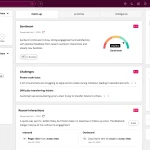Think about the last time you called customer support. You probably shared your name, maybe an account number, perhaps even a credit card. It’s a transaction we do without a second thought. But behind that simple interaction lies a complex, high-stakes dance of data privacy and security.
Honestly, this isn’t just a technical issue. It’s the bedrock of customer trust. When you hand over your personal information, you’re placing a tiny piece of your digital life in someone else’s hands. For businesses, protecting that data isn’t just about compliance—it’s about keeping a promise.
Why Data Security in Customer Service is Non-Negotiable
Let’s be clear: the support desk is a goldmine for attackers. It’s the one place in your company where sensitive data is verbally exchanged, typed into systems, and shared across channels daily. A single lapse here isn’t a minor oops; it’s a full-blown breach waiting to happen.
And the stakes? They’re incredibly high. A data breach can lead to massive financial penalties under regulations like GDPR and CCPA, not to mention the irreversible damage to your brand’s reputation. Once trust is broken, it’s a long, hard road to get it back. Customers have long memories when it comes to their personal information being mishandled.
The Modern Support Landscape: Where Vulnerabilities Hide
Gone are the days of just phone calls. Today’s customer support is a multi-channel beast—email, live chat, social media DMs, even video calls. Each new channel is another door that needs a strong lock.
Social Engineering: The Human Firewall
This is the big one. Phishing attacks, where a scammer pretends to be a legitimate customer, are becoming scarily sophisticated. They use urgency, emotion, and clever storytelling to trick even seasoned agents into bypassing protocols. Training your team to spot these attempts is, well, everything. It’s about building a human firewall that can sense when something just feels… off.
Internal Threats and Simple Mistakes
It’s uncomfortable to talk about, but internal threats are real. Sometimes it’s malicious, but more often, it’s a simple, human mistake. An agent might email a customer’s sensitive data to the wrong person, leave a logged-in computer unattended, or use an unsecured personal device for work. These aren’t acts of villainy; they’re moments of distraction with serious consequences.
Building a Fortress: Practical Steps for Secure Support
So, what does a robust data privacy framework for customer support actually look like? It’s a mix of technology, training, and culture. Let’s break it down.
The Principle of Least Privilege (PoLP)
This is a fancy term for a simple idea: agents should only have access to the data absolutely necessary to do their job. An agent handling billing inquiries doesn’t need the same system access as one resolving a technical bug. By segmenting access, you minimize the potential damage from any single account being compromised.
Robust Authentication and Verification Protocols
Before an agent reveals any personal information, they must verify the caller’s identity. But the old “mother’s maiden name” question isn’t cutting it anymore. Best practices now include multi-factor authentication (MFA) and knowledge-based questions that aren’t easily found on social media.
Here’s a quick comparison of verification methods:
| Method | Pros | Cons |
| Security Questions (e.g., “First Pet’s Name”) | Familiar to users, easy to implement | Often easily researched or guessed |
| One-Time Passcodes (SMS/Email) | Dynamic and time-sensitive, much more secure | Relies on customer having access to their device/email in the moment |
| Biometric Verification (Voiceprints) | Extremely secure and convenient for the user | Higher implementation cost and requires customer opt-in |
Encryption: The Unbreakable Lock
All data, whether at rest in your database or in transit during a chat session, must be encrypted. Think of it as putting the information in an unbreakable safe. Even if someone intercepts it, they can’t read it without the key. End-to-end encryption for chat and email is no longer a luxury; it’s a baseline expectation.
Continuous, Engaging Agent Training
A one-time training session during onboarding is pointless. Data privacy training needs to be ongoing, engaging, and scenario-based. Use real-world examples of phishing attempts. Run drills. Make it a game. You need your agents to be vigilant, not just compliant.
Key training topics should absolutely include:
- Recognizing social engineering tactics.
- Proper data handling and disposal procedures.
- Secure password and authentication practices.
- How to escalate a suspicious interaction.
Transparency: Your Secret Weapon for Building Trust
Here’s a counterintuitive truth: being open about your data practices actually builds stronger customer relationships. When customers know how their data is protected, they feel more secure sharing it.
Be upfront in your privacy policy. Explain, in plain language, what data you collect during a support interaction and why. Assure them it’s encrypted and won’t be used for purposes they didn’t agree to. This transparency turns a potential point of friction into a moment of connection.
The Human Element in a Digital World
At the end of the day, all the technology in the world can’t replace a culture of security. It’s about empowering your support agents to be the first and best line of defense. It’s giving them permission to say, “I’m sorry, I need to verify your identity before I can proceed,” even when the customer gets frustrated.
That slight friction, that momentary inconvenience, is the sound of a promise being kept. It’s the quiet assurance that their digital life is safe with you. And in a world where data is currency, that assurance is everything.
So the next time you review your support strategy, look beyond the average handle time and customer satisfaction scores. Look at the data. Ask the hard questions. Because the security of your customer’s information isn’t a metric on a dashboard. It’s the foundation upon which every single interaction is built.





